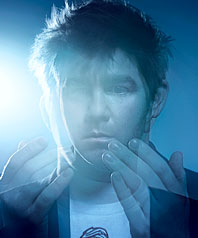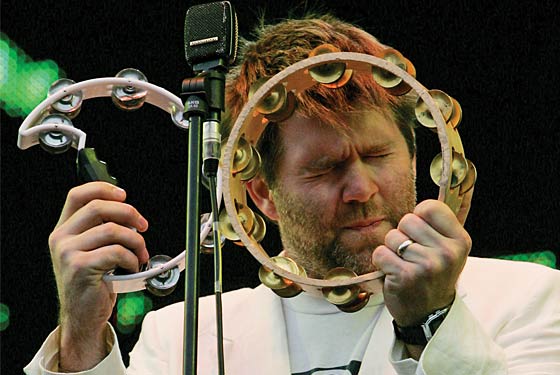
Without James Murphy, New York might still be a musical museum. That’s what it was like when he rose up alongside the “New York rock renaissance”—the tag applied, around 2000, to the surge of young bands like the Strokes, the Yeah Yeah Yeahs, and Interpol. The story then was that New York had reemerged with a sound and a style to call its own. The city was back on the map. Downtown was cool again. But was it?
The problem with the rock renaissance was that it played out like a Renaissance fair—with rockers in skinny ties and black leather preening like jesters and old- master painters at a living-history festival. It was an exercise in pure nostalgia.
James Murphy was nostalgic, too, but he yearned for a New York where sounds collided and styles followed suit, as outgrowths of creative chaos rather than traditions to fall back on. The only way to serve such a legacy was to reinvent it, so Murphy did what all restless scenemakers do—he started throwing parties.
Set in the empty lobby of a West Village office building, these affairs were legendarily wild, unhinged from any one scene. “We had some of the original graffiti writers, Zulu Nation kids, guys who worked in movies, smelly Brooklyn punks, old dance-music people, Rosie Perez on crutches—it was the weirdest mix of people you could ever see,” Murphy says. “I used to take two ecstasy pills, break them into quarters, and put them on the corners of the two turntables, and work my way through them as a D.J. set went on. I played Donna Summer, Kraftwerk, Public Image Ltd., the Beatles, the Stooges—anything. It really felt like something was happening.”
What was happening was a desegregation of sounds that made Murphy one of the city’s most celebrated musical characters. The disco-rock style he championed managed to stick, and he’s since plied it in a number of different guises: as a globe-trotting D.J., as a producer volleying ideas in his studio with the likes of Britney Spears, and as the leader of one of New York’s most exciting bands, LCD Soundsystem. All of Murphy’s work draws on an idea he proposed in his role as accidental impresario—that rock and disco could be reacquainted and could make a city move.
Murphy has never been mistaken for the disco type. “I remember him as a kid who always wanted to talk about Beowulf,” says Rob Reynolds, who met Murphy in the early nineties and later worked with him. “He was like an accountant in a Division III tight end’s body with an artist’s heart and soul.”
Murphy grew up a suburban punk-rocker in Princeton Junction, New Jersey, where he stayed for a year after high school to train as a competitive kickboxer (he still speaks with pride about his reputation as the weird kid who never lost a fight). In the late eighties, he moved to New York to attend NYU and immersed himself in the music scene, with dispiriting results. “So much of the New York rock scene then was like high school, just perpetual reaffirmations of social standing,” says Murphy, who is now 37. “I hate adults who fall prey to the same shit that children fall prey to.”
Murphy stumbled across one band that had the same feelings about the scene he did—they called themselves Dungbeetle, and their ranks included Reynolds (now a painter in Los Angeles), Nicholas Butterworth (who figured prominently in the dot-com boom), and a singer who wore capes onstage and answered to the name Sam Shit (he is now the celebrated novelist Sam Lipsyte). “Dungbeetle were like Andy Kaufman,” says Murphy. “When Andy Kaufman performed, he was not just trying to be funny. He was playing with the notion of what it means to try to be funny, of what it means to be an audience expecting somebody to be funny. He was doing a dance and playing a game. Watching Dungbeetle was like being involved in that game.”
Murphy signed on as a sound mixer for Dungbeetle’s “art-punk theatrical” stage shows, and built his first real recording studio with them on a desolate block in Dumbo. The neighborhood was then full of empty warehouses and characters like a Serbian truck driver who fought their studio noise with his own. “He would write pseudo-profound graffiti on the door when he got drunk or angry,” Lipsyte remembers. “Stuff like, NO ABILITY TO LOVE, NO CAPACITY TO FORGIVE—TAKE IT! There was always a danger when we were playing that this guy would burst through from the next room with a sledgehammer.”
Dungbeetle never amounted to much—they put out just one vinyl single—but it’s hard to imagine New York looking and sounding the way it does now without the ideas the group seeded in James Murphy. All involved in the game remember him as a meticulous sound engineer with much invested in the grand gestures the band aspired to. “James was the person turning up the volume on it all, literally and figuratively,” says Juan Maclean, a current disco-rock artist who ran in the same circles with a band called Six Finger Satellite. “He was the guy who was like, ‘Oh, you’re confused by this? This rubs you the wrong way? Well, here it is 100 times louder.’ ”
“We all had roughly the same worldview,” says Lipsyte. “But James was actually going to do something with it.”

In 1999, a 26-year-old English rave veteran named Tim Goldsworthy came to New York from London to produce a dance-music album; Murphy was tapped as studio engineer, though he cared nothing for dance music. “Our relationship was very sitcom-esque,” Goldsworthy says. “He was the big loud American who played the drums and everything else, and I was the quiet English guy who couldn’t play anything and sat in front of a computer.”
The duo bonded over boredom with New York, which they agreed was in a dire musical and cultural state with nothing but a legacy to trade on. “This is where all the music I’d always referenced comes from,” says Goldsworthy. “I expected break dancing on every corner. But then I came here and there was nothing going on whatsoever, just boring clubs and expensive bottle-service places.”
Gradually, Goldsworthy brought Murphy around to the pleasures of dance music. Drugs helped. Goldsworthy remembers the first time Murphy took ecstasy: “The D.J. put on ‘Tomorrow Never Knows’ ”—the Beatles song with booming drums on Revolver—“and James was there dancing with his eyes closed. Everybody formed a ring around him and started chanting his name. James looked out and was like, ‘Yeah!!!!!’ ”
It was with Goldsworthy that Murphy threw his early parties and started working as a D.J., with an unusual participatory style—rather than stay hidden behind his turntables, he would jump out on the dance floor and throw his fists in the air. He took to his role as a cult hero and devoured anything that would keep him charged. “My 30th-birthday cake,” he says, laughing, “was 30 lines of coke on a Roxy Music record.”
With a scene catching on around them, Murphy and Goldsworthy started their own music production team and record label, both of which are known as DFA, short for Death From Above. Among the DFA roster of dance-rock acts is Murphy’s own LCD Soundsystem, which started as a “theoretical band.” Murphy positioned himself as dual figure—part rock star, part traitorous D.J. The LCD sound melded the synthetic rhythms of disco with rock’s cocksure vocals and loud guitars. The lyrics were pointed and off the cuff in the classic punk style. Murphy loved to rant against snobbery in all its incarnations.
The first LCD Soundsystem album sold 235,000 copies worldwide, and in the wake of it, Murphy toured the world and became something of an ambassador for a new kind of downtown New York. He also landed remix commissions for big acts like the Chemical Brothers, Nine Inch Nails, Gorillaz, and Justin Timberlake as well as a 45-minute exercise track contracted by Nike. The legendary Britney session, however, was a bust. “It was very strange —we were both lying on the floor, head-to-head, working on lyrics in a notepad,” says Murphy. “She seemed eager to please, but it went nowhere. She went to dinner and just never came back.”
LCD’s new Sound of Silver is warmer and more personal than the first album, the product of an artist aging along with his own scene. Murphy still does plenty of hilarious sneering; on “North American Scum,” behind a bashing beat, he pokes fun at Europeans’ condescension (and condescends right back, describing a European city as “where the buildings are old and you might find lots of mimes”). Other songs cast Murphy as more roundly human, vulnerable, even sentimental. In “All My Friends,” he longs for youthful nights spent simply hanging out, and on the last song, “New York I Love You (But You’re Bringing Me Down),” he unburdens himself of his still-conflicted feelings about the city. Crooning unevenly over plaintive piano chords, Murphy rips into those he deems responsible for sterilizing New York, like the “cops who were bored once they’d run out of crime” and the “billionaire mayor who’s now convinced he’s a king.” The new record, says Murphy, is about being “honorable to perspectives that really come from me. Because that’s the way I think I should do things now.”
I t’s early on a Saturday, and Murphy is stumbling around his apartment with his wife, a model turned designer named Mandy Coon. They live in Williamsburg, in a refurbished building next to a garage adorned with orangutan graffiti. Murphy has work to do in the city, and Coon is eager for him to leave so she can finish embroidering an astronaut on a shirt for his birthday. Before he makes his exit, Murphy says good-bye to the other recent love of his life: Petunia, a French bulldog with an unflappable mug.
It’s here that Murphy has settled, comparatively speaking. There are bits of gray showing in his stubble. He doesn’t do drugs like he used to, and he’d sooner stay home with his wife and his dog than be out dancing past dawn. Coon sits on the couch, next to a Bauhaus chair with a homey afghan spilling over chrome bars. She remembers how crazy Murphy used to be when he was in his partygoing prime, how wasted he had to get just to get onstage with LCD Soundsystem. “He’s an intense guy,” she says with a laugh. “But he’s a lot calmer now.”
Calmer, maybe, but hardly calm. Murphy hasn’t lost his irrepressible impulse to convert all those around him to whatever his current passion is. “I can be staggeringly evangelical,” he admits. “That’s just my personality. Like jujitsu; I wanted to do jujitsu, so I started a fucking school!”
On certain days and nights, the West Village building where he once threw his parties and where DFA still has its studio and office changes form, with blue padding laid out from wall to wall. Murphy wanted to do jujitsu, so he bought Olympic-grade mats and got Adidas to sponsor him with uniforms—$300 robes with wraparound belts. He gathered friends and started a secret “DFA Fight Club,” which includes as many as sixteen members and supporters of New York’s disco-rock scene.
One night while shaping up for a short European tour, Murphy changed into his jujitsu suit (called a gi) and, under the direction of his Brazilian trainer, started rolling around on the same floor where he had danced and drugged and otherwise did what he could to revitalize New York. His eyes opened wide as he practiced a move called the Flying Guillotine, which involves locking an opponent by the neck and letting his own weight get the better of him. The trainer jumped into the fray and barked a command: “Remember,” he said, “work with what you have.”